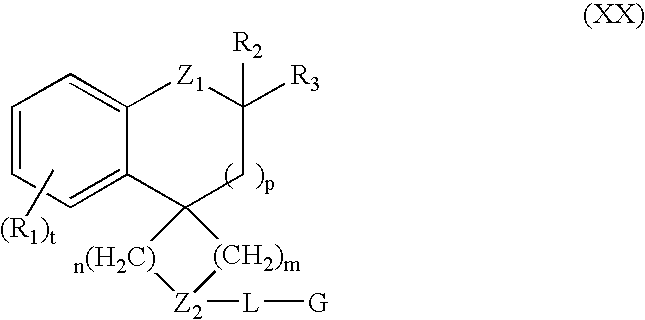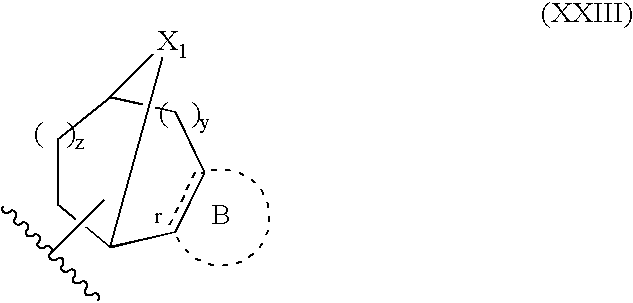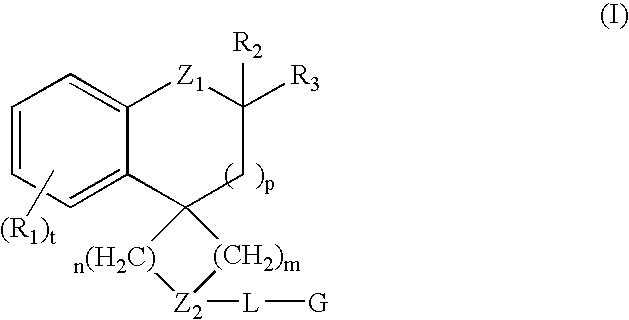Modulators of muscarinic receptors
a technology of muscarinic receptors and modulators, which is applied in the field of modulators of muscarinic receptors, can solve the problems of significant activation of the parasympathetic autonomous system, difficult to assign specific functions to individual receptors, and small progress, and achieve the effect of increasing activity and/or efficacy
- Summary
- Abstract
- Description
- Claims
- Application Information
AI Technical Summary
Benefits of technology
Problems solved by technology
Method used
Image
Examples
preparation b
Synthesis of bicyclo[3.2.1]octane-2-carbaldehyde
[0260] Bicyclo[3.2.1]octane-2-carbaldehyde was prepared using an analogous procedure as for Intermediate 1 from commercially available bicyclo[3.2.1]octan-2-one. The crude products were used in the next step without further purification.
Preparation C
Synthesis of 7-oxa-bicyclo[2.2.1]hept-5-ene-2-carbaldehyde (C4)
[0261]
[0262] To a stirred solution of furan (C1) (15 mL, 200 mmol) and acrolein (C2) (6.7 mL, 100 mmol) in DCM (25 mL) was slowly added AlCl3 (666 mg, 5 mmol) under argon at −43° C. (dry ice / isopropanol bath). The reaction mixture was stirred at −43° C. under argon for 30 min, and then quenched with saturated aqueous K2CO3 (50 mL). After the reaction mixture was gradually warmed to room temperature, it was extracted with ether (200 mL×5). The combined ether extracts were washed with saturated aqueous K2CO3 (200 mL×2) and saturated aqueous NaCl (200 mL×2), dried over MgSO4, filtered, and concentrated to give 2.6 g of oily cru...
preparation d
Synthesis of ethyl 4-formylpiperidine-1-carboxylate (D3)
[0264]
[0265] 1.0 eq 4-piperidinemethanol (D1) (10.00 g, 86.8 mmol) was dissolved in dichloromethane (350 mL), cooled in an ice water bath and treated dropwise with a solution of 1.05 eq ethyl chloroformate (9.89 g, 91.1 mmol) in dichloromethane (50 mL), followed by the dropwise addition of a solution of 1.0 eq triethylamine (8.78 g) in dichloromethane (50 mL). The reaction was stirred at ˜0° C. for 15 minutes, then at room temperature for 10 min. The reaction was diluted with dichloromethane (250 mL) and washed successively with (150 mL each) H2O, 0.1 N HCl (aqueous) (×2), saturated brine, then dried (Na2SO4) and filtered. The filtrate was concentrated in vacuo to afford 15.60 g ethyl 4-(hydroxymethyl)-piperidine-1-carboxylate (D2) as a viscous, pale bluish-green oil. 1H-NMR (400 MHz, CDCl3) δ4.15 (br m, 2H), 4.09 (q, J=7.1 Hz, 2H), 3.46 (d, J=6.4 Hz, 2H), 2.72 (br t, J=12.4 Hz, 2H), 2.07 (s, 1H), 1.70 (m, 2H), 1.63 (m, 1H), 1...
example 1
1′-((1R,2R,4R)-bicyclo[2.2.1]hept-5-en-2-ylmethyl)spiro[indene-1,4′-piperidin]-3(2H)-one (Cpd No. 237)
[0279]
[0280] To a solution of compound N-Boc Spiroindane 1i (60.0 g, 0.21 mol) in CH2Cl2 (1000 mL) was added H2O (500 mL), TBAB (6.9 g, 0.02 mol) and KOH (3.5 g, 0.06 mol) and followed by addition of KMnO4 (70.0 g, 0.45 mol) in several portions. After stirring for two days at 35° C., another quantity of KMnO4 (70.0 g, 0.45 mol) was added and the mixture was continued to stir for 2 days. After Na2SO3 (103.0 g, 1.0 mol) was added in portions at 5° C., the mixture was extracted with EtOAc. The combined organic layers were dried over anhydrous Na2SO4 and evaporated under vacuum. The residue was purified by column chromatography (PE / EtOAc:5 / 1) to yield 1ii (30.0 g). 1H NMR (CDCl3) δ: 7.74-7.72 (m, 1H), 7.66-7.64 (m, 1H), 7.62-7.61 (m, 1H), 7.49-7.38 (m, 1H), 4.22-4.20 (m, 2H), 2.89-2.82 (m, 2H), 2.63 (s, 2H), 2.02-1.94 (m, 2H), 1.56-1.52 (m, 2H), 1.49 (s, 9H). MS (ESI) m / z (M+H+) 246.0 / ...
PUM
| Property | Measurement | Unit |
|---|---|---|
| Fraction | aaaaa | aaaaa |
| Angle | aaaaa | aaaaa |
| Composition | aaaaa | aaaaa |
Abstract
Description
Claims
Application Information
 Login to View More
Login to View More - R&D
- Intellectual Property
- Life Sciences
- Materials
- Tech Scout
- Unparalleled Data Quality
- Higher Quality Content
- 60% Fewer Hallucinations
Browse by: Latest US Patents, China's latest patents, Technical Efficacy Thesaurus, Application Domain, Technology Topic, Popular Technical Reports.
© 2025 PatSnap. All rights reserved.Legal|Privacy policy|Modern Slavery Act Transparency Statement|Sitemap|About US| Contact US: help@patsnap.com



